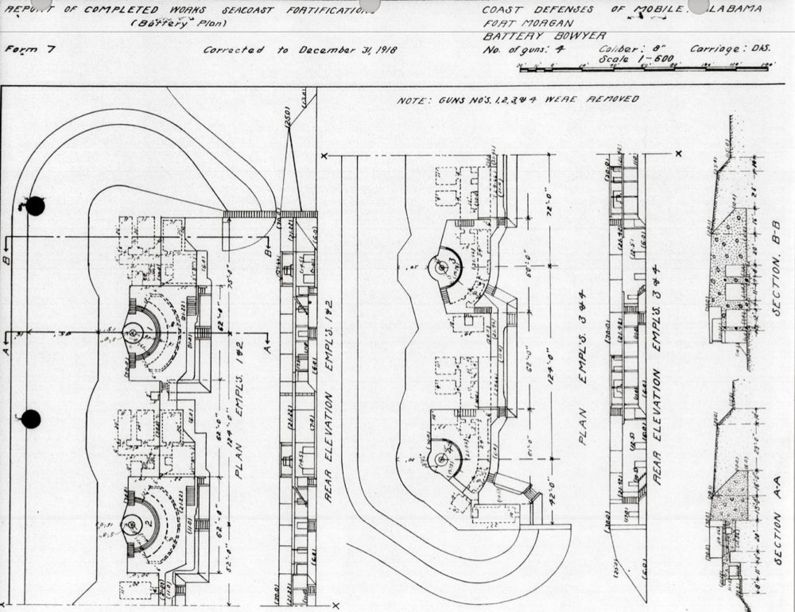Battery Bowyer
|
Battery Bowyer (1898-1917) - Battery Bowyer was a reinforced concrete, Endicott Period 8" coastal gun battery on Fort Morgan (1), Baldwin County, Alabama. The battery was named in G.O. 43, 4 Apr 1900, after Colonel John Bowyer, U.S. Army, a distinguished soldier, after whom the fort in Mobile Point was named in 1813 which repulsed the British Fleet 15 Sep 1814. Battery construction started in 1897, was completed in 1898, and transferred to the Coast Artillery for use 28 Sep 1898 at a cost of $ 187,811.94. Deactivated in 1917.
Endicott Period (1890-1910)Part of the Harbor Defense of Mobile, Alabama. Originally built as an Endicott Period concrete coastal gun battery with two 8" M1888MI and two 8" M1888MII guns mounted on two M1894 disappearing carriages and two M1896 disappearing carriages. This was a two-story battery with the gun loading platform on the second level and the magazines on the first level. Hoists were required to move the heavy projectiles from the magazine level to the loading level. The first versions of these hoists were believed to be Hodges hoists which were later replaced with Taylor-Raymond hoists in 1909. Emplacements 1 and 2 had front-loading hoists and emplacements 3 and 4 had backloading hoists. Battery Bowyer was initially equipped with a 5 KW direct current electrical power plant when it was first accepted in 1898. In 1908 the power plant was upgraded with a 15 KW direct current motor-generator set from Fort Wadsworth, accepted for service 23 Sep 1908.

World War I (1917-1918)The U.S. entry into World War I resulted in a widespread removal of large caliber coastal defense gun tubes for service in Europe. Many of the gun and mortar tubes removed were sent to arsenals for modification and mounting on mobile carriages, both wheeled and railroad. Most of the removed gun tubes never made it to Europe and were either remounted or remained at the arsenals until needed elsewhere. On 24 Aug 1917 the four gun tubes at Battery Bowyer were ordered dismounted for use abroad. On 21 Dec 1917, the gun cards indicate that the gun tubes were transferred to Watervliet Arsnal for modification. Only one of the guns was actually shipped to France, another went to Hawaii and the remaining two were shuffled between storage sites until they were scrapped. After the removal of the guns, the left flank of the battery structure was used for a post telephone and fire control switchboard, and emplacement #3 was modified to house a radio station, both in 1920. Current StatusPart of Fort Morgan State Park, Baldwin County, Alabama. No period guns or mounts in place.
Sources: Links: Visited: 1 Oct 2021, 23 Dec 2011, 10 Dec 2009 Picture Gallery
| ||||||||||||||||||||||||||||||||||||||||||||||||||||||||||||||||||||




